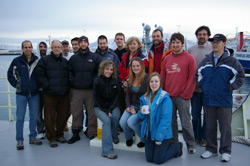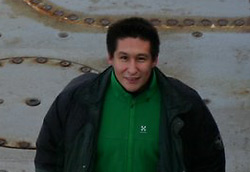An Ending by Dallas Murphy
It’s snowing this morning, Wednesday. Again. The sky shows its usual various shades of grey, but the seas are flat. Watch passes to watch in the engine room, on the bridge, the deck, and in the galley. Dr. Bob and Kjetil remain at their computers processing data, and the CTD operators continue to deliver more. In appearance, all seems the same as it did 25 days ago. But the end of our cruise is at hand. In two hours, we’ll suspend the study to steam for Reykjavik, 42 hours from our last CTD station. From there, the science staff will go our separate ways after a month in close quarters. Some crewmembers will leave the ship for vacation, but most will see the nearly empty ship (“deadheading,” they call it) back to her homeport of Woods Hole, Massachusetts. After the ship passes her inspection by the U.S, Navy, she’s bound for the Pacific, via the Panama Canal, to the Galapagos and Hawaii. Thursday morning now, we’ve rounded that claw of headlands and fjords on the northwest corner of Iceland, and Second Mate Derek has laid a southerly heading for Reykjavik, ETA 0800 Friday. That means this is our final post. So let’s make a few generalizations about oceanography and more specifically about the objectives of this cruise. Let’s begin with the latter: Long before he joined Knorr for this cruise, Dr. Bob posed for himself two questions: How does the water enter the Denmark Strait, and how does it exit? One theory held that the water flowing south in the East Greenland Current fed directly into the Strait, and because that water was cold and salty, it sank, sliding down the inclining bottom south of the ridge and entraining neighboring water as it plunges over the ridge into the deep Irminger Sea. Yes, there is that, said two of his Icelandic colleagues, but the main source of the “Denmark Strait Overflow” water, they contended, arrived via the “north-Iceland jet.” Cold, dense water followed the Iceland shelf over the top of Iceland, bent to the south, joining the East Greenland Current and then, together, the two types of water dropped over the waterfall into the Irminger Sea. An intriguing idea. Ocean water, remember, retains, as it flows over great distance, its temperature/salinity (T/S) fingerprint. So Dr. Bob set about to measure the Iceland jet in detail by slowly sailing northward, stopping the ship every few miles to take measurements. If the jet existed, he would find its fingerprint. Sure enough, to make a long, arduous study short, it’s there, and it may indeed form the majority of water entering the Strait. Bob meant also to determine how the East Greenland Current (EGC) exited the Strait. That’s where those seven moorings—armed with Profilers taking continuous measurements for the last year—come in. The simple scenario was that the water flowed into the Strait over the crest of the hill and then down into the deep Irminger, but the ocean is seldom simple. Dr. Bob suspected that some quantity of the dense water remained up on the Greenland Shelf. If so, how then did it find its way into the deep Irminger Sea? This, remember, is the stormiest region in the world ocean—and East Greenland, 3,000 meters high, stands right in the storms’ way. This is the “barrier” we talked about, and it is the reason why the atmospheric scientists brought their balloons and radiosondes aboard. The counterclockwise- whirling storms track into the Irminger Sea, and when the winds encounter the high coast, they bend and accelerate to the south over the East Greenland Current. This action causes Bob’s water up on the shelf (a “shocking” amount, in his words) to spill over the edge in spurts and “fall” into the Irminger Sea. To learn these things—remember I’m making a long story short—required 30-days of round-the-clock ship operations and will also mean many months of staring at the mooring data. Why do it? Well, the Denmark Strait is, as we’ve said, of vital importance because its water forms the headwaters of the Deep Western Boundary Current, which is the main route of return flow southward for the water that flowed north in the Gulf Stream System. Nature insists that if water flows north, then an equal quantity of water must flow south. If it did not, Western Europe would submerge and the hemisphere would be plunged into a new ice age. No one is saying that this is going to happen, but it illustrates the importance of the Denmark Strait Overflow. Its through-flow is vital to the continued health of our climate. And that brings up another matter—the breakup of the Greenland Ice Sheet due to global warming, dumping unprecedented quantities of freshwater into the Strait and the Irminger Sea. If that quantity of freshwater is sufficient to dilute the ocean’s salinity, decreasing its density, then the water will likely freeze on the surface instead of sinking. One of the greatest threats, therefore, to our climate’s health lies right here in these waters east of Greenland. This leads in turn to another crucial point, perhaps the most important point for us to take away from this expedition. Everything in nature is connected to everything else. The air we breathe, no matter where we live, is linked inextricably to the ocean. The ocean and air communicate directly with the ice in the Arctic and the Antarctic, with the rainforests in the tropics and the boreal forests in the mid-latitudes. Oceans transport heat (among other things) from the tropics, where there is too much, to the high latitudes where there is too little, thereby striking a comfortable medium. The oceans warm or chill the air, and the great wind systems of the world carry the warmth or the cold onto land. There is great beauty and elegance in this interaction, and to appreciate the unity of nature’s systems does not require a Ph.D. from an institution of higher learning, only citizenship in the world. And what does it add up to, all these geophysical forces acting in concert? Climate. These forces simply are. But now a new geophysical force has shouldered its way into the mix, namely us. The works of our minds and hands have already altered the world, for the better in some instances, but we have also uprooted entire ecosystems and driven far too many animals and plants to extinction. We have also changed, with our very way of life, the climate of the world. If we continue to do what we’re doing, beyond some yet unknown point, we will break the links that sustain nature’s unity, and nature will make a new one. Chances are, we won’t be happy with it. However, let’s not speak of doomsday scenarios. Let’s think instead about new ways to live in the world, recognizing that nature does not exist for our use. It just so happens that nature is presently configured such to benefit us and the creatures in their various habitats living on Earth. But nature’s systems are delicate; we can sever them; we can use them up. Let’s not do that. Let’s find ways to sustain the gifts. And this brings us back to science and scientists. Scientists seek to understand the mechanisms behind the great natural systems. Dr. Bob and his colleagues, not only in oceanography but in all branches of Earth science, focus on small pieces of the systems, since no one person or science can address the whole. But scientists are professionally obligated to present their work to the public. It’s up to us to make the effort to understand what they are telling us about the globe we live on. The voyage of the Knorr filled a small corner of knowledge about the ocean and its interaction with the atmosphere in this remote but vital corner of the world. She will make other voyages with other scientists and crews, and perhaps, who knows, some of you will be members of one or the other. Speaking for myself, it has been a pleasure to be a part of this one. I’ll miss this fine ship and new friends; I’ll be sad to walk down her gangplank for the last time. But then maybe we’ll all meet again sometime in this or some other ocean. For now, bless this ship and all who sail in her. Ukiaq by Nick M?ller
Avataani ukiup nillertilernerani mallit pissatikkiartulerfianni, ilisimatuut paasisassarsiorlutik angalapput. Ilisimatuut akornani ipput Bob Pickart akisussaasuunerpaaq, ikiortaailu Kjetil Våge aamma Thomas Spengler. Allateqatiga Dallas Murphy, inuk atuakkiortorsuaq allakkaangami atuaruminarluinnartunik oqaaseqatigiiliortartoq angalaqataavoq. Aput, siku aammalu anori imaannarsuarmi angalanitinni naapittarpagut, ilaatigullu silap pissusaanit naalakkersorneqartarluta naak angorusutagut tamakkerusukkaluarlutigit, anoraata imarsuup pissusa paaseqqunngitsutut pissuseqarluni, paaserusutatinnik kinguarsarpaatigut piffissarli pineqartillugu pitsuusutut misiginarpoq, tassami aqagu paasisassarsiorneq naammassissammat. Ulloq kingulleq by Nick M?llerIppassaq naggasiinissaq ullumikkumut kinguartissimavarput Dallas Murphy aamma Bob Pickart soqutiginartumik sammisaqarnerat pissutaalluni, ullumikkullu Bob Pickart apeqqarissaarfigaarput angalanerup inernerisaanik, qanorlu angalaneq nalilerneqarsinnaaneranik tusarniaavigalugu. Ippassaq misissuinerit naggataarlugit CTD imaanut aqqartinneqarpoq, tamatumalu kingorna Reykjavik-mut ingerlaarneq aallartilluni. Ulloq atoruminarluinnarpoq seqinnerluni silaannarilluni, anoraa sakkukitsuinnaavoq, tusalkkallu naapertorlugit Kalaallit nunaata kitaani sila anorersuartorsuuvoq siallerlunilu. Aallaqqaarnitinniit imaani nalunaarsuinissat (CTD) naatsersuutigineqarsimapput 150-sit, misissuinerli ingerlalluarsimammat massakkumut kisitsisitigut takusinnaalerparput nalunaarsiunerit 263 ingerlanneqarsimasut. Tamanna angalanerup ingerlalluarsimaneranik takussutissaavoq, ataatsimummi eqikkarlugu angalaneq paasisassarsiorneq ajunngilluinnartumik inerneqarpoq. Naak paasisassarsiornermi katillugit ullut arfineq marluk annaaneqarsimagaluartut, ullunik annaasaqarfiit tamarmik silap atoruminaanneranik pissuteqarput. Massakkumut paasisat ilikkakkallu aallaavigalugit, oqarsinnaalerpugut nunarsuup silaata, imartaata nunataatalu tamarmik ataqatigiilluinnartut. Siulianimi oqaatigineqareerpoq anori, sermeq imarlu ataqatigiittut arlaallu allanngorpat, allanut sunniuteqassalluni, ataasiinnaq allanngorsinnaanngilaq. Silaannaarp kissatsikkiartorneranik (allannguut siulleq) sermeq aattoriartulissaaq, kissatsinnerali annertusiartortillugu aattornera sukkanerulissalluni, sermeq aattortoq amerlanerpaatigut imaanut naaffeqartarpoq, imerlu nillertoq imaata kissassusa sunnertarlugu (allannguut tulleq). Silaannaq imarlu kissarnerulerneranit imeq silaannarmut aalannguutartoq annertunerulersarpoq, siallertarneralu sakkortunerulersarluni, tamanna anorlernerusalerneranik malitseqakkajuttarpoq (allannguutit pingajuat). Taamatullu nunarsuarmi silap pissusa imminut ataqatigiittuupput, soorlu eqqaaneqartut piffimmi annikitsumi allannguutit silap pissusaanut assigiinngitsunut sunniuteqartartut. Imarsuarli pineqartillugu allannguutaasinnaasut sunniutaasinnaasullu piffik innertunerusoq takorloorneqartariaqassalluni, Nunarsuaq. Eqqaaneqareersutut imaq sarfartuartuuvoq nunarsuup imarpissui tamaasa aqqusaarlugit ingerlaarfigisarlugit, ingerlaarnerminilu kiassuseq, tarajoqassuseq aammalu immap silaannaqassusia allanngorartarluni. Piffimmi kiannerusumiit imaq ingerlagaangami, soorlu Atlantikup avannaata imartaanit Norge-p imartaanut nunattalu imartaanut pigaangami tarajoqarnerulersarpoq, tamatumani pissutaavoq, silaannarmi kiannerusumi imeq imaaniittoq aalannguulluni silaannarmut pisarmat. Kujammullu ingerlaqqikkaangami nillernerusumiit sermersualimmiit iluliarsualimmiillu, imaq tarajukinnerusarpoq nillernerusarlunilu piffimmi nunat killiit kiannerusuni. Taamatorluinnaq aamma imarsuit sumiiffii ungasikkaluartut imminnut ataqatigiissuupput, arlanni allannguteqartoqarpat imarpinnut allanut allannguut sunniuteqassaaq, tamannalu sunnertiffimmi silap pissusaanut allannguissalluni. Assersuutitut taasinnaavarput misissuiffigineqartumi immap Atlantikut avannaaneersoq, avannaanut ingerlasimaleriarluni kujammut ingerlaqqittarnera, Island-p tunulli akornani aqquteqartoq ataasiusumik, tamaanilu immaq tarajoqassusia kissassusaalu apeqqutaalluinnarlutik, kujammut imaq ingerlaqqittartoq. Silaannaap kissarnerulerneranik aallaaveqartumik immap tarajoqassusia kissassusaalu allannguuteqassappata, kingunerisinnaava nunarsuup ukiui nillertut (istid) takkussinnaanera. Tamanna arlaqalersuni uppernarsineqarnikuuvoq sermersuarmi qillerilluni misissuinertigut, takuneqarsinnaammat nunarsuup ukiua nillertoq piffissap sivikitsut ingerlanerani, silaannaap pissusa ukiut qulit missaata ingerlanerani allannguuteqarsinnaasoq annertuumik. Uani paasisassarsiorluni angalanermi paasisat massakkumut takussutissiinerat naapertorlugu, oqarsinnaanngilagut silaanap kissatsikkiartornera qaqugu sutigullu sunniuteqassanersoq. Tamanna ersarinnerusumik oqaatigineqarsinnaalissappat sukumiisumik misissuinerit aammalu paasissutissanik siusinnerusukkut pigisanut sanilliunneqartariaqassammata, tamatumalu kingornatigut allannguutit allat tukassutaasinnaasut pigineqartullu aamma tunngavilersuinissami atorneqartariaqassammata. Paasisassarsiornerit massakkut naammassineqartut siunissami silaannaap minnerunngitsumillu immap pissusaanik takusaqalersinnaanermut tapertaasussaapput, misissuinerit ingerlateqqinneqarumaartut Bob Pickart oqaatigiva, piffissarli aningaasaqarnerlu apeqqutaajumaarput qaqugu paasissaarsiorluni angalaqqittoqarnissaanut. Ilimagiinnarnagu qulakkeerlugu naatsersuutigisinnaavarput Kalaallit nunaat suli annerusumik ilisimatuunit paasisassarsioriartortunik siunissami tikinneqartarnissa, ullumikkullu ilisimatuut ukiut tamarluinnaasa tikittarput misissuiartorlutik. Sulilu annerusumik nunarput nunanit allanit soqutigineqarnera annertusiartorpoq, silaannaammi allanngoriartornera kalaallit nunaani sermersuup silallu pissusa apeqqutaalluinartussaapput siunissami silap nunarsuullu qanoq isikkoqarumaarnissaanut. Neriuutiginaqaaq misissuinerit kalaallit nunaanit annerusumik peqataaffigineqartalerumaartut, periariffissallu pitsaanerusut ilinniartitaanikkut atugassat aallunneqarluassasut. Silaannallu pissusaanik aammalu immap pissusaanik misissuinerit soqutigineqarneri annertusaavigineqarumaartut, atuarfeqarfinni qaammarsaanertigut aammalu sukumiisumik oqallisigineqartalerumaartut suut aqqutigalugit ilinniarfiit soqutiginartut qaffasissullu anguneqarsinaanerat. Soqutiginninnissinnut qujalluta malinnaanissinnullu neriulluta nunatsinni aammalumi nunarsuup sinnerani immap pissusaanik paasisaqarluarsimassasusi, neriuutiginaqaarlu siunissami ilinniaqqinnissassinnut annerusumik takussutissiisimalluta. Inussuarnersumik inuulluaqqusilluta umiarsiarmi tamarmik inuttat, neriullutalu siunissami taamatut suleqatigiinneq atorluarumaarlutigu. Knorr Last updated: October 30, 2008 | |||||||||||||||||||||||
Copyright ©2007 Woods Hole Oceanographic Institution, All Rights Reserved, Privacy Policy. | |||||||||||||||||||||||


